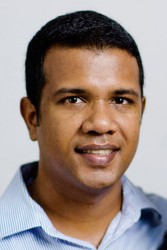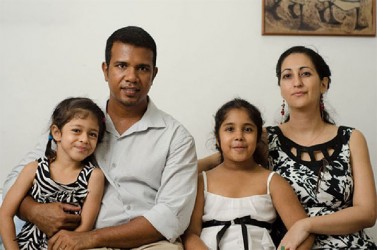By Rae Wiltshire
There are two things that seem to be strongly linked to creativity – pain and cultural mixing. Almost all great works of art have evidence of these two ingredients and when award-winning photographer Fidal Bassier revealed that he had spent a great deal of time in Israel, immediately cultural mixing came to mind.
If you doubt that pain and cultural mixing are essential ingredients for creativity, The Scene encourages you to read and analyse some of your favourite books, paintings, television shows, movies, or whatever creative outlet you are interested in. When it comes to analyses, it is also wise to study the artists as well.

Even if these two elements are not at the forefront of an artist’s work, they are hidden underneath. There is a guarantee you will find them and if you don’t, then you are obligated to dismiss this article as misleading.
If you had the opportunity to view the Guyana Visual Arts Competition Display at Castellani House last year, you would have come across a photograph that captures the sadness of life in the face of a homeless man who looks like he had gone through a series of tragedies. He is staged in the centre of the photo and in the background is a vibrant Mashramani celebration. The photo really sums up human nature.
It was this photo that won Fidal the first prize in the Photography segment of the Guyana Visual Arts Competition.
Fidal is the genius behind the lens of 55 Photography, where he offers such services as weddings, portraits and event coverage. But he does more than that and his randomly shot images are usually compelling.
In a presentation at Moray House last September Fidal described himself as “not a typical wedding photographer.” He explained that he is always looking for the unusual, off guard moment: a bride having her makeup done, or waiting to get out of a car. Often there are no people in the picture – just the rings on a prayer book or an exquisite bouquet, he elaborated.
In an interview with The Scene, Fidal briefly stepped from behind the lens:
Question: Who are you?
Answer: From a family of 4 siblings, I grew up in Guyana, and my family spent a few years in Trinidad and then Tobago before moving back here. I met my wife, who is from Tanzania, while I was serving at the Baha’i World Centre in Israel and we have two daughters.

hair and beard jump out of the photo. The bleak colour of his clothing and his hair texture really contrast with the vibrancy in the background.
Q: How did you come into contact with photography?
A: As a child I remember looking at my father’s film camera and old photos. I then had the opportunity to travel to Haifa, Israel where I took photos of my stay there, the beautiful landscape and the people I served with. After returning, my father bought a digital point and shoot camera and it has continued from there.
Q: What did you do before?
A: Before becoming a full-time photographer I worked with a video production company working the video camera and doing video editing and before that I was doing odd jobs.
Q: What does photography mean to you?
A: It means a lot and I do not think I could describe it in detail but two things come to mind; preserving memories and storytelling.
Q: Why did you choose to invest so much time in photography?
A: I feel it’s an important part of life. We benefit so much from what was recorded in the past. I would like to record something of my life, of society for future generations, like my daughters’.

Q: What drives you to create?
A: I don’t feel I create images, I try my best to record what is happening at the time.
Q: Can you describe your photographic evolution for me?
A: Tough one. I think it’s still evolving.
Q: Is there a specific process you have when creating an image?
A: Not really, I just hope to tell a story with images. Sometimes it works and sometimes it doesn’t. While there are photographers who create or stage scenes, and there is nothing wrong with that, I prefer to capture things as they happen, candid shots.
Q: What are some of the most vital pieces of advice you can give to young photographers?
A: Funny enough I still consider myself learning to be a photographer. I would advise them to read and study other photographers, learn your equipment and practice as much as you can.
Q: How do you want to be remembered?
A: That I would have been of some service to my family and country.
Q: Can you list some artists who inspired you?
A: There are many talented photographers out there who I try to learn from; and thank goodness for the internet. But I have gained so much from our own local photographers like Nikhil Ramkarran, Karran Sahadeo and Michael Lam.
Q: Many artists have a particular style and they are prone to subjectivity, what’s your favourite type of photography?
A: Portraiture.
Q: How important is it to study the history of photography?
A: Just like a lot of other things in life, it’s important to know where it started and how far it has come.
Q: Name five of your favourite movies?
A: I like a variety of movies but none really stand out as favourites.
Q: If you died and realized cameras are only allowed in hell would you go to heaven or move in with the devil?
A: Would I pick my camera over being close to God? No.





